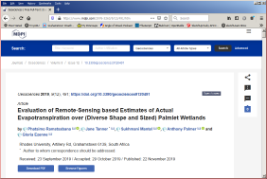
There is a general lack of information regarding wetland functioning and processes in South Africa, especially with respect to their hydrology. Palmiet wetlands in particular are understudied and there is limited scientific knowledge about their evaporative demands. In a semi-arid setting like South Africa, evapotranspiration (ETa) significantly affects catchment water balance. Therefore, it is important to consider how evapotranspiration can be quantified with reliable accuracy in order to improve monitoring and management of wetland ecosystems.
The research looked at a range of available estimates of evapotranspiration ETa over six South African palmiet wetlands, which are key ecological structures in terms of water regulation and sediment trapping. Three remote sensing based products (a local product, FruitLook, and two global data products, MOD16 ET and EEFlux) were compared across different rainfall years (2008 to 2019). Their outputs were validated, where possible, with limited ground-based scintillometer data on the Krom palmiet wetland, which indicated that MOD16 and EEFlux were most representative of ground-based measurements. The small pixel size EEFlux data were compared over three wetlands with ETa over increasing buffers of land cover (100, 500, 1000 m) in order to validate the perception of these wetlands being high water users. While larger wetlands had slightly higher evaporative demands than adjacent areas, ETa over a small wetland was similar to neighbouring land cover. The results indicate that palmiet wetland ETa is highly variable and dependent on external factors such as climate, wetland size and seasonality.
Authors: Phatsimo Ramatsabana , Jane Tanner, Sukhmani Mantel , Anthony Palmer and Gloria Ezenne
Paper may be accessed at: https://www.mdpi.com/2076-3263/9/12/491/htm
